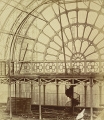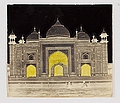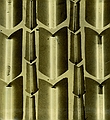| Newsletter for Collectors - Vol 11.1 | January 17, 2017 | | | Home • What‘s New • Photographers • Online Exhibitions
Contents • Alphabetical • Styles and movements • Articles
Visual Indexes • Galleries & Dealers • Timelines • Techniques
Library • Contact us Welcome to another Luminous-Lint Newsletter.
Connections are everything... |
As I've mentioned in previous newsletters photography is about objects but photohistory is about connections as they provide the stories and context. In this Newsletter I'll show examples of some of the connection types used within Luminous-Lint that make it an essential resource for scholars, educators and lovers of photography.
Subject based connections |
Subject based connections are similar to tags as they serve as labels to bring together images on a related subject. Most institutions only handle the images within their own collections whereas Luminous-Lint uses thousands of collections and orders the connections into Visual Indexes with a narrative.
Spiral staircases
These spiral staircases taken by Philip Henry Delamotte, László Moholy-Nagy and Heinz Hajek-Halke have the same subject matter but address it in different ways.
I‘ve yet to see an exhibition on the staircase or ladder in photography but there are many eye-catching examples. | 
LL/40210 | 
LL/58908 | 
LL/48099 |
Geographically based connections |
Another connection type addresses photographs that were taken at the same geographical location but what becomes more interesting is when the viewpoint is almost identical. In some cases the photographers appear to have stood in almost exactly the same spot but did they know of the earlier photographs?
Colossi of Memnon, Egpt
The two colossi of Amenophis III stand about 20 metres high close to a now destroyed mortuary temple in Egypt. The Classical writer Pausanias described them as follows:
In Egyptian Thebes, on crossing the Nile to the so called Pipes, I saw a statue, still sitting, which gave out a sound. The many call it Memnon, who they say from Aethiopia overran Egypt and as far as Susa. The Thebans, however, say that it is a statue, not of Memnon, but of a native named Phamenoph, and I have heard some say that it is Sesostris. This statue was broken in two by Cambyses, and at the present day from head to middle it is thrown down; but the rest is seated, and every day at the rising of the sun it makes a noise, and the sound one could best liken to that of a harp or lyre when a string has been broken. (Pausanias, 1918, Description of Greece, (Harvard University Press; William Heinmann Ltd.)
There are large numbers of photographs of this archaeological monument including those by Félix Teynard (1851-1852), Francis Frith (ca 1857), François Joseph Edouard de Campigneules: (1858), Antonio Beato (1860s), Francis Bedford (1862) and no doubt many others.
Why was this? Did they know and imitate the photographs of earlier photographers or is there something more fundamental about the nature of composition? | 
LL/69185 | 
LL/21203 | 
LL/70034 |
Technique based connections |
The examples used for ""Geographically based connections" above include a waxed paper negative by François Joseph Edouard de Campigneules that was auctioned in Paris in November 2016 and this brings us to connections that are based on the techniques and processes used within photography.
Have the same subjects consistently been photographed using different techniques? Well yes and no - you can find a lot of photogravures of sheep taken by Pictoriatists but it is hard to find gelatin silver prints of sheep taken by Modernist photographers. There are many clues to different mindsets hidden within these connections.
Paper and waxed paper negatives
Early paper and waxed paper negatives are fragile and exhibited with caution. For each technique Luminous-Lint includes a full range of indexes. As the examples come from diverse collections subscribers can access rarely seen works and see them in context. | 
LL/25795 | 
LL/28254 | 
LL/13230 |
Each year in photography is effectively a visual time capsule that is accessible on Luminous-Lint encouraging exploration of themes.
The year 2000 in photographs
These head-and-shoulder shots, all from 2000, are part of a large series on contemporary portraiture. Subscribers can explore groupings within genres by the time they were taken this can elucidate trends. For photographers it encourages awareness and for others visual exploration and hypothesis building. | 
LL/23654 | 
LL/51961 | 
LL/31081 |
Visual similarity connections |
Another way of linking photographs is to seek out images that have a similar visual structure even though they were taken for different purposes.
The appearance of spheres
These three photographs come out of distinct genres - astronomy, Modernist experimentation and sports and yet they all appear to be studies of spheres. | 
LL/37367 | 
LL/7202 | 
LL/37490 |
The study of form
Another series of visual similarity connections includes photographs by Edward Steichen, Karl Blossfeldt and Peter Keetman from advertising, typological analysis of the natural world, and commercial photography to highlight form. | 
LL/29199 | 
LL/14451 | 
LL/48278 |
As Luminous-Lint grows complete sets of significant photographs are added in and one of these is Camera Work. At present around 70% of the photographs are included and this will improve over the coming months.

Alfred Stieglitz, "Camera Work, No. 1, 1903, January
Metropolitan Museum of Art, Alfred Stieglitz Collection, by exchange, 1953, Accession Number: 53.701.1
There are publications where these can be seen and there are online sources for many of the images but the difference on Luminous-Lint is in the connections subscribers can see.
When fully implemented the images from each number will be shown along with variants. It will also have Visual Indexes showing the photographs by each photographer but these are only the starting point and more connections will be added. For example the image published in Camera Work may be a photogravure but Luminous-Lint will provide examples of gelatin silver prints, platinum prints and magic lantern slides of the same image scattered through institutional and private collections.
All this is useful but we can go far further using the visual histories Luminous-Lint already has to provide context. A Clarence Hudson White photograph of The Ring Toss (1899) is part of the history of the photography of children just as Edward Steichen's photographs of Rodin‘s scandalous statue of Balzac (1908) can be a node in a history of the photography of sculpture starting with the daguerreotypes by Daguerre and the calotypes by Talbot.

Edward Steichen, "Balzac - The Open Sky", Camera Work, no. 34a, pl. 02
1908 (taken) 1911 (photogravure)
Philadelphia Museum of Art, Gift of Carl Zigrosser, 1966, Accession Number: 1966-205-34a(2)
Having images of the photogravures, rotogravures and halftones published in Camera Work is a useful resource for curators, researchers and scholars but it is their significance within the multiple threads of photohistory that enhances our understanding of visual, social and technical trends.
Photographic rarities and "The Rule of Fives"... |
"The Rule of Fives" and "The Plea to the Collector" sound like cases for Sherlock Holmes but this is not in praise of the acting abilities of Benedict Cumberbatch but a request to you as a collector.
Some months ago I was visited by Robert Jackson, a collector of vernacular photography, and we were discussing the images I‘m seeking to improve Luminous-Lint. At the time I proposed that if a collector has been searching for images for decades and only seen five or fewer of a particular type of photograph then it is probably rare.
Photographic rarities
I‘m now seeking these rarer images so if you have a Daguerreian Premium, Bosco photobooth portrait, or scissors with a photograph in them let me know. What have you got in your collection that you‘ve seen nowhere else or you know is rare?
Thanks to everybody sending through examples of your recent discoveries. | 
LL/9780 | 
LL/68696 | 
LL/47171 |
If you have five photographs or less of any subject or type - I‘m interested. What intrigues you and you find difficult to locate or you want to learn more about?
Who knows we might find you a kindred spirit with similar interests even though Luminous-Lint isn‘t a dating agency!
Enriched Photohistory Exhibition Catalogues - an experiment... |
Luminous-Lint is now ready to do a number of experiments with exhibition catalogues to demonstrate how we can enhance knowledge and accessibility. I'm seeking the content of a few catalogues for multi-photographer exhibitions where the copyright of the photographs and text is not an issue. Exhibition catalogues on nineteenth century photography would be ideal and the catalogue doesn't have to be recent. These will be used to construct online systems that enhance their content with additional examples, texts, biographies, videos etc to demonstrate how exhibition catalogues can retain their brand but at the same time become part of an enriched body of knowledge.
For each volume I'm seeking:
- The full text, including introduction, essays, footnotes, biographies and checklists (open PDF or MS Word)
- Copies of all images at a reasonable resolution - anything over 1000 pixels on the longest edge (TIFFs can be converted at this end but JPGs are preferred)
- Any branding images and text required
There are no costs to organisations and they can be involved in any display decisions. This project is about working collaboratively to explore ways of furthering the dissemination of knowledge on photohistory.
Suggestions for possible collaborations are most welcome so send me an email at alan@luminous-lint.com
Subscriptions are available to access 1200 Themes on Luminous-Lint, powerful Visual Indexes, tools to contextualize single images, reading lists, specialized indexes and some of the more detailed parts of the website. Luminous-Lint is an evolving resource where all parts are enhanced and added to every day. Your support is necessary for this unique project to flourish.
Details about subscriptions
Thanks to all those subscribing to, and supporting, Luminous-Lint as it continues to improve.
If you would like to give a gift subscription to an individual, or an institution, that is simple to arrange so send me an email at alan@luminous-lint.com for details.
All the best, Alan |
|
John Demos (1944, 17 January - ) was born - Greece, Thessaloniki. Portraits of Greece and the rituals that are carried out. His book ‘Shadows of Silence‘ received excellent reviews.
Herbert G. French (1872, 17 January - 1942, 25 June) was born - US, KN, Covington. American photographer whose work was published in Camera Work in 1909.
Izis (1911, 17 January - 1980, 16 May) was born - Lithuania, Mariampolé. Lithuanian-born photographer, active in France.
William Eddowes (1827, 10 September - 1880, 17 January) died - Ireland, Sandymount.
Sir Francis Galton (1822, 16 February - 1911, 17 January) died - England, Surrey, Haslemere. British polymath who used photography to better understand scientific principles.
William James Mullins (1860, 21 August - 1917, 17 January) died - US, PA, Pittsburgh.
Eugene Piot (1812, 11 November - 1890, 17 January) died. Early French antiquarian, art collector and photographer who travelled in Greece and Italy and had his portrait taken by Gustave Le Gray. |
| |
|

